“If you want to explain and know how to tell a brand’s story, use story, anecdote, or analogy.” ← I can’t remember where I heard that—or if I just invented it in some conglomeration of inhaling books and media about marketing and story—but I believe it’s true.
Storytelling is a business buzzword, but I often need big, dreamy words to be broken down bite-size for me. Today, I want to drill down to 24 ways you can ACTUALLY implement storytelling in your creative small business—starting with why you would want to do that in the first place.
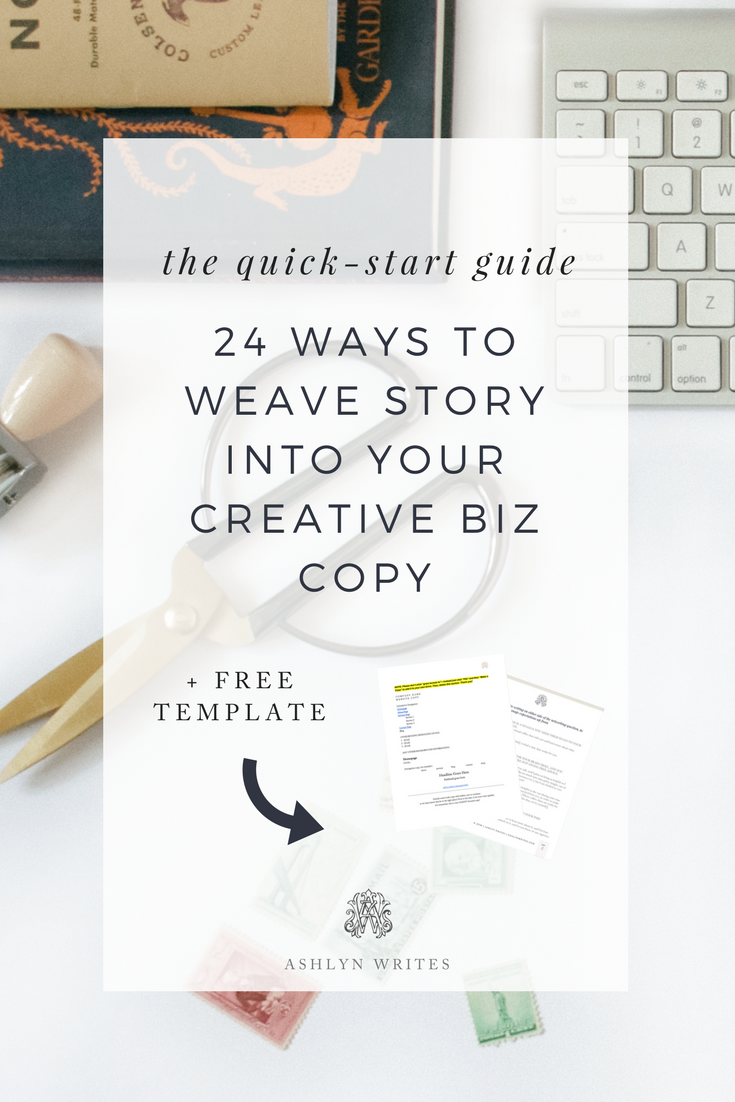
As a member of the millennial generation, I truly believe we sit at a unique place when it comes to media and storytelling, and writing in general: we grew up on Disney and bedtime stories, but then came Oregon Trail, AOL Instant Messenger, and chat rooms.
With college-ruled notebook paper, we learned to diagram sentences with ballpoint pen—which was juxtapositioned with breaking all those same rules with short texts and wall posts.
Learning to write was an interesting process if you grew up a millennial like me.
But there’s one thing that sticks through all the medium shifts:
Story.
“Stories, more even than stars or spectacle, are still the currency of life. There’s no escaping stories, or the pressures to tell them.” – The New Yorker
I love how it’s woven in us to gravitate toward storytelling. Our brains are wired to connect soul to soul when there’s a tale woven in the mix.
So yes. I want to back it up for those of you who can geek out on data like I can with WHY that works, and give you 24 ways you can weave story into copy for your creative business.
3 Pillars of Why Story Sells
Built-in story only reinforces your website, Instagram feed, about page, email copy, and more. Here are three reasons why sharp, story-centered copy matters.
In all three, I think you’ll see the overarching theme …
… basically, narrative story feels less pitchy. Win!
01. We’re moths to the flame (even subconsciously) for conflict, risk, and adventure.
We don’t like boring chick flicks (Well, we DO like predictable when we don’t “want to think.” Right?! The Bachelor, anyone? I put it on because I do zero thinking.). We want the knight in shining armor to fight for us. We want to be the hero that came out on top and survived the struggle.
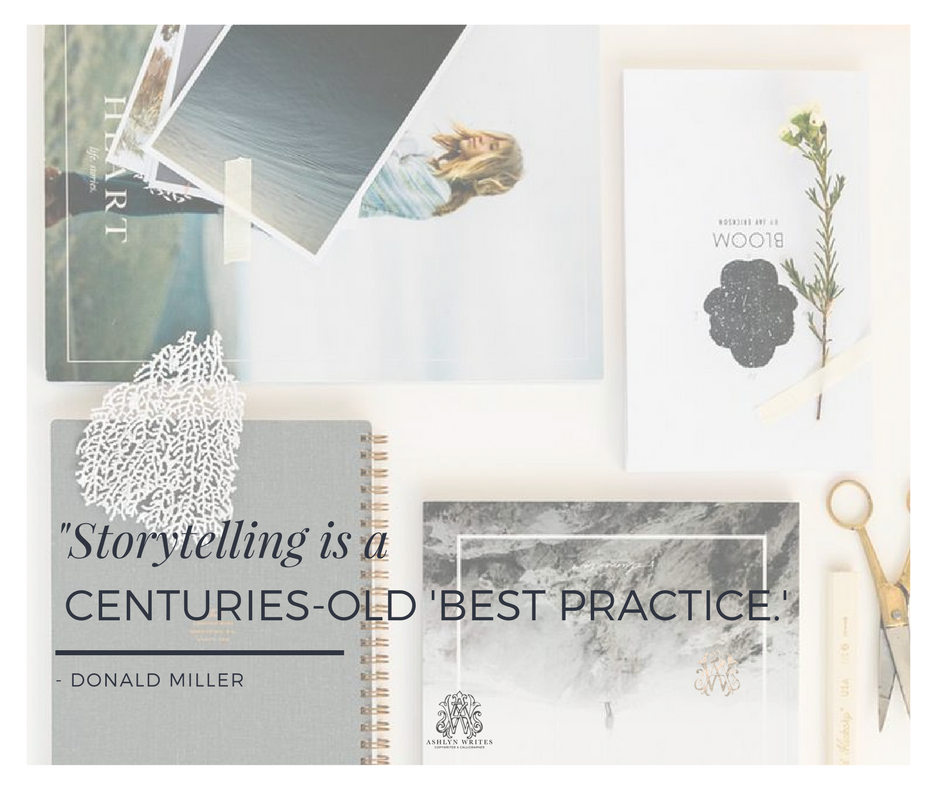
Storytelling permeates the fibers of our humanity so deeply that the practice predates farming and agricultural practices. In fact, storytelling is so innate, that you likely spend 30-50% of your day daydreaming (not counting the moments spent in pillow-rested, silk eye-mask dreams!) according to a Harvard study.
And, interestingly, when you’re having those Netflix sessions, according to studies, your brain rarely daydreams during that time… why? Because the screen does it for you.
“Long before the first formal business was established … the six most powerful words in any language were Let me tell you a story.” – Mathews & Wacker, What’s Your Story
Those facts fascinate me. Somewhere between one third and half of my day, my brain’s wheels churn to tell a tale. I heard somewhere that’s a survival tactic, and it makes sense: I can plan for what’s could happen in the future when I allow my mind to wander out of the present.
02. We remember story—it sticks.
As I mentioned earlier, our brains check out when we can predict the story. But our brains remember the joke, remember the anecdote, and get the illustration.
(Well, unless you’re like me and remember everything but the punchline. ????♀️)
If you want to sell anything, do it with story, anecdote, or analogy.
It’s why great speakers and teachers use fables and tales (Ahem, Jesus, Aesop, and TED Talks): According to psychologist Jerome Bruner, we are twenty times more likely to remember a fact if it’s told to us with or in a story.
The best emails in my inbox catch my eye because they tell me an unexpected story I never saw coming. Look at this one, from Courtney Foster-Donahue (who’s Facebook marketing course recently opened—nope, not an affiliate, but CHYUP, you should take it. SO GOOD!).
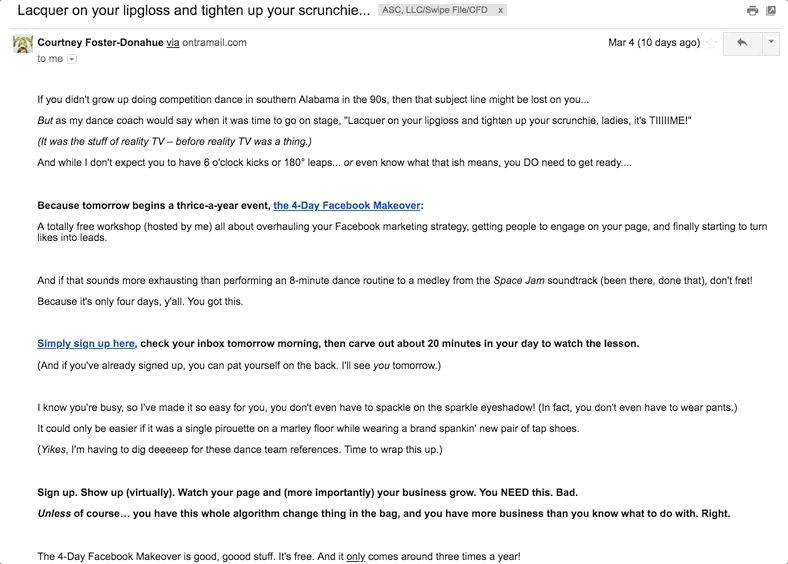
The best conference speakers and webinar hosts, enthralling authors, professors, and even some of my favorite girlfriends or family members earned their stripes in my book in part due to their knack for weaving words and truth into a tale or story.
A well-told story is remembered more accurately than boring facts and figures.
03. They’re universal.
Stories are demographic-proof, and no matter the age, race, or gender, we like them. Watch your mind the next time you’re listening to something “boring,” and see how your brain flits on when a new story starts.
Storytelling works for every type of learner: visual learners picture it, auditory learners hear it, and kinesthetic learners experience and feel it.
(I have LOVED my Michael Hyatt LeaderBox subscription—you’ve probably heard me talk about it—because it’s pushed me to read things that, I’ll be honest, I would completely walk right past 100 times out of 100 days in the bookstore. But Lead with Story by Paul Smith came in December’s box, and it was fascinating if all of this topic of story interests you, if you’re a leader, or if you do public speaking.)
“Experience is the best teacher. A compelling story is a close second,” Smith said. Heard!

Where to use story in your creative business
Basically, whenever and wherever you’d give advice, teach something, or explain something, you can use story.
To note, storytelling looks a lot less like you being the hero and more like you being the guide to your client as the hero, as you come in to assist her on her path to greatness.
Simply put, in your brand story, you’re the guide equipping your hero client.* The story can be about you, but it’s goal should be to help your customer or client by telling it.
You can use story in:
- Your website: From your about page to your services pages, to even long-form sales pages
- Your weekly email newsletter
- Pieces of your welcome sequence … and fo’ sho’ a sales sequence
- Conferences, podcasts, or talks … any kind of training you do or are invited onto
- Video: YouTube, Facebook Live, Instagram Live
- Case studies or testimonials—tell me about those customer successes
- Team meetings to explain a point
- Meet-ups … what if you came armed with one to share with one person so they remembered you?
- Your blogs
*If that biz concept is new for you—and it’s totally cool if it is … I’m excited for you!—dig into Donald Miller’s Storybrand podcast (episodes 1-7 in season 1 explain that well!), his book, or look into Joseph Campbell’s theory about the hero’s journey. He was kinda the first one that pulled it into an explanation that made sense for people, even though it’s basically the narrative for every good story ever.
Where do you find story ideas?
Okay, so now I hope you’re starting to see how you could weave this in …
But now comes the kazillion dollar question: Where do you get them!?
I get it. I’m a writer, and I’ve just as easily thought “but I have no stories!” You do … you just have to remember them. And house them somewhere. Lysa TerKeurst has said she before, as a writer, wants to be a “noticer of life.”
[bctt tweet=”If you want to become a writer, just become a noticer of life.” username=”via AshlynSCarter”]
When you notice life, all is grist for the mill.
Everything can turn into a story!
To get you going, here are 15 questions to help you find your story ideas.
- How have you overcome what your audience is working against?
- What was it like meeting your industry girl-crush?
- What stories have you read in books that are a foil to something going on in your life and business now?
- Ask friends and family—got a good story for me?
- What did you see happen today?
- What’s a moment in your job you learned an important lesson?
- What’s the biggest problem that’s happened to you at work—and how’d it end up?
- How did you come up with the most creative idea you’ve ever had?
- What’s a work relationship you have? Tell us about it!
- What did you learn from one of the first jobs that you still use today?
- What stories have other people told you? (hint-hint: How has your business changed someone’s life?)
- Is there something from a movie or TV show?
- Can you retell a news story that happens to support what you’re about, or what your positioning is?
- What rite of passage stories do you have from growing up?
- What is a historical anecdote that sticks out in your brain—does it look like something going on in your business or current market?
Now, the important thing is to PUT them somewhere.
All my Copywriting for Creatives students and any of our one-on-one copywriting clients know that we have entire buckets of data that we don’t use—we just keep on hand as a bank.
I call it a Copy Bank, but Jessica Rasdall, my speaking coach-turned dear friend, has a brilliant idea for a story bank. I remember thinking it was the craziest, most Type A idea to record stories on a Trello board… until I read Lead with a Story where the author suggests creating a story matrix spreadsheet—then I realized Jess was onto something. 🙂
Here’s a little screenshot of her story bank, and a link if you want to copy it!
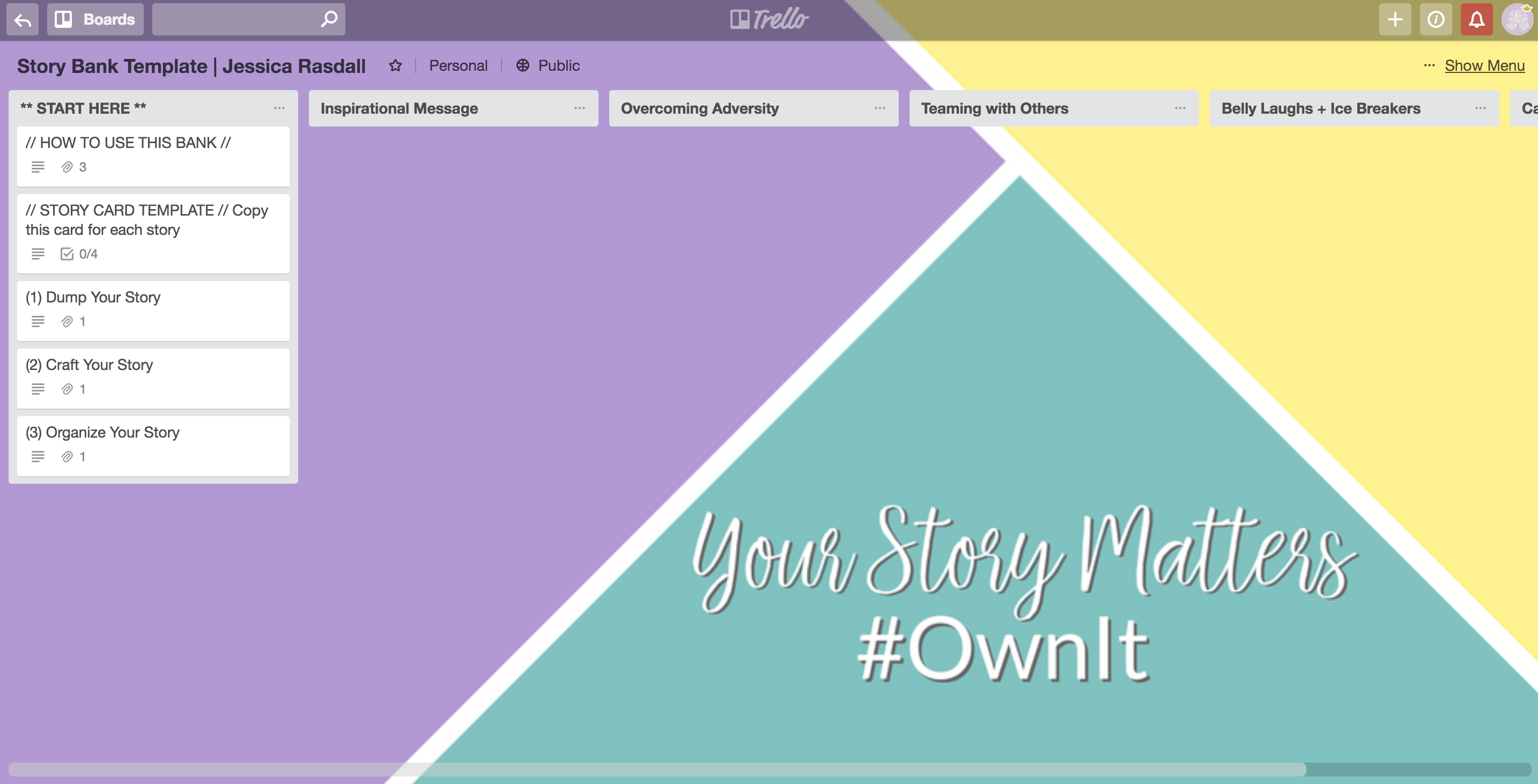
Jess recommends that you take time at the end of the day to unload stories. After I first heard her say this, I did it for about a week or so, and here’s the cool thing: Eventually, I’ve just gotten better at remembering stories … the “noticer of life” thing kicked in.
And there you have it! Just remember—like all copywriting—clarity trumps cleverness. Be clear. Weave story into simple, digestible facts. Donald Miller in his StoryBrand framework reminds us that the human brain is wired to do two things:
- Survive
- Conserve calories
So, when sharing story, simplify, simplify, simplify. Make your services (and especially how to buy them!) easy as pie to understand. Look for ways to weave storytelling about your about page, business copy, or blog into your next copywriting assignment, let the words rest for a day, and come back and edit with fresh eyes before you hit publish.
Related: Click here to read my blog on how to self-edit like a pro.
It’s soul-stirring to know you can help guide someone toward their truth, and recognize how they can pursue something greater than themselves all by implementing story and communicating clearly. Picture yourself as a guide to usher your reader towards what you want them to realize—and remember, you certainly don’t have to have it all figured out or have the perfect story to speak up! Sometimes, it’s best if we feel someone sitting or walking alongside us, and that’s what storytelling can do. No matter what your blog or business, your platform has given you the opportunity to steward a message and that’s pretty exciting.
Reading Time: 8 Minutes
So Ashlyn, pardon my ignorance, but what do you mean when you say “brand storytelling” for my company?
A sweet client asked me this the other day. Great. Question.
Storytelling looks a lot less like you being the hero than it does your client being the hero — and you coming in as the guide to assist him or her on path to greatness.
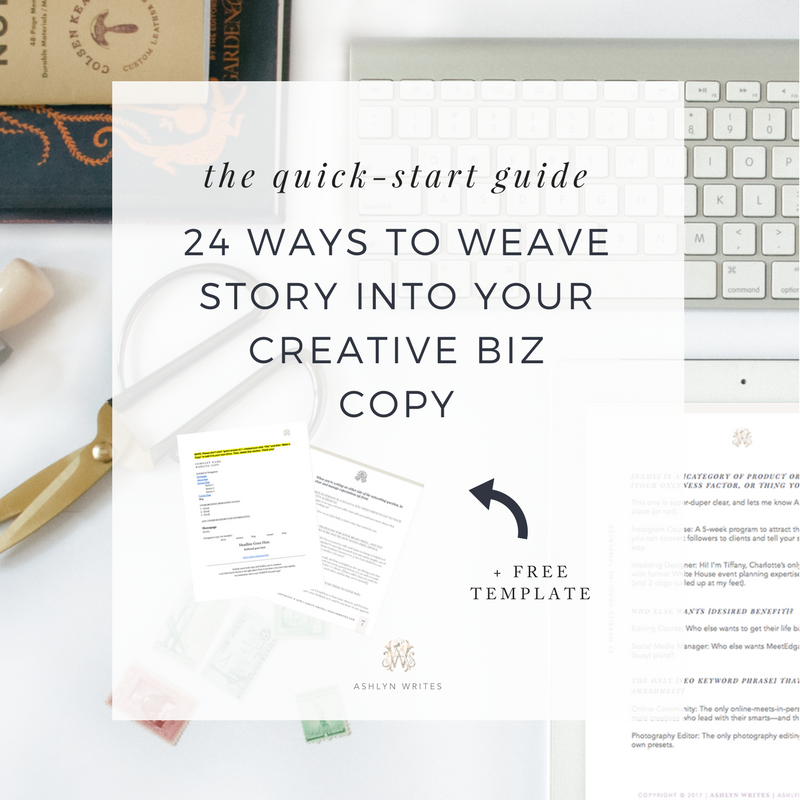



You’re so right! I started incorporating stories into my weekly e-mail broadcasts, and have seen a surge in my e-mail open rate because of them. They also consistently increase my know, like, and trust factor, so that when I promote my paid products, my audience is much more likely to purchase. I’ve also written an entire blog post that shares my journey: How I Created My Own Website From Scratch Without Technical Knowledge.